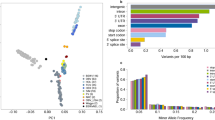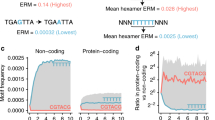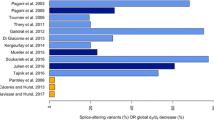Abstract
About 2/3 of introns are inserted between G and G/A, which has previously been explained by codon usage frequencies existing during the period of intron insertions. However, less is known about the evolution of exonic splicing sites. Exonic nucleotides that frame introns are involved in both protein coding and splicing. While a compromise between protein coding and splicing constraints is achieved differently in each intron phase, AG|G is the most common site in all phases comprising about one quarter of all such sites. There is also a great variety of other splicing sites. Here we examine evolutionary changes in exonic nucleotides located at positions −2 −1|+1 which occurred after the beginning of eutherian radiation using comparisons of orthologous splicing sites from five mammalian species. AG|G accumulated fewer substitutions and was more conservative than less frequent exonic splicing sites. Such trend could potentially increase frequencies of AG|G during mammalian evolution and cause a decline of less common sites which had higher substitution rates. However, there is a limit to this process determined by the dynamic equilibrium of substitution rates and the frequencies of different splicing sites. It seems that this equilibrium was already achieved at the time of eutherian radiation and a moderate increase in AG|G frequency was observed only in the human genome.







Similar content being viewed by others
References
Abril JF, Castelo R, Guigó R (2005) Comparison of splice sites in mammals and chicken. Genome Res 15:111–119
Dibb NJ, Newman AJ (1989) Evidence that introns arose at proto-splice sites. EMBO J 8:2015–2021
Duret L, Semon M, Piganeau G, Mouchiroud D, Galtier N (2002) Vanishing GC-rich isochores in mammalian genomes. Genetics 162(4):1837–1847
Karolchik D, Kuhn RM, Baertsch R, Barber GP, Clawson H, Diekhans M, Giardine B, Harte RA, Hinrichs AS, Hsu F, Miller W, Pedersen JS, Pohl A, Raney BJ, Rhead B, Rosenbloom KR, Smith KE, Stanke M, Thakkapallayil A, Trumbower H, Wang T, Zweig AS, Haussler D, Kent WJ (2008) The UCSC genome browser database: 2008 update. Nucleic Acids Res 36:D773–D779
Li W-H, Graur D (1991) Fundamentals of molecular evolution. Sinauer Associates, Inc, USA, p 284
Long A, de Souza SJ, Rosenberg C, Gilbert W (1998) Relationship between “proto-splice sites” and intron phases: evidence from dicodon analysis. Proc Natl Acad Sci USA 95:219–223
Murphy WJ, Eizirik E, O’Brien SJ, Madsen O, Scally M, Douady C, Teeling E, Ryder O, Stanhope MJ, de Jong WW, Springer M (2001) Resolution of the early placental mammal radiation using Bayesian phylogenetics. Science 294:2348–2351
Nguyen HD, Yoshihama M, Kenmochi N (2006) Phase distribution of spliceosomal introns: implications for intron origin. BMC Evol Biol 6:69
Rogozin IB, Sverdlov AV, Babenko VN, Koonin EV (2005) Analysis of evolution of exon–intron structure of eukaryotic genes. Brief Bioinform 6:118–134
Ruvinsky A, Ward W (2008) Intron framing exonic nucleotides: a compromise between protein coding and splicing constraints. Open Evol J 2:7–12
Ruvinsky A, Eskesen ST, Eskesen FN, Hurst LD (2005) Can codon usage bias explain intron phase distributions and exon symmetry. J Mol Evol 60:99–104
Schwartz SH, Silva J, Burstein D, Pupko T, Eyras E, Ast G (2008) Large-scale comparative analysis of splicing signals and their corresponding splicing factors in eukaryotes. Genome Res 18:88–103
Sella G, Petrov DA, Przeworski M, Andolfatto P (2009) Pervasive natural selection in the Drosophila genome. PLoS Genet 5(6):e1000495
Sheth N, Roca X, Hastings ML, Roeder T, Krainer A, Sachidanandam R (2006) Comprehensive splice-site analysis using comparative genomics. Nucleic Acids Res 34:3955–3967
Sorek R, Ast G (2003) Intronic sequences flanking alternatively spliced exons are conserved between human and mouse. Genome Res 13:1631–1637
Sverdlov AV, Rogozin IB, Babenko VN, Koonin EV (2004) Reconstruction of ancestral protosplice sites. Curr Biol 14:1505–1508
Taylor J, Schenck I, Blankenberg D, Nekrutenko A (2007) Using galaxy to perform large-scale interactive data analyses. Curr Protoc Bioinformatics. Chapter 10:Unit 10.5
Acknowledgment
The authors are grateful to Lawrence Hurst and Brian Kinghorn for discussion and useful advice.
Author information
Authors and Affiliations
Corresponding author
Rights and permissions
About this article
Cite this article
Babenko, V., Ward, W. & Ruvinsky, A. Does Drive Toward Canonic Exonic Splicing Sites Exist in Mammals?. J Mol Evol 70, 387–394 (2010). https://doi.org/10.1007/s00239-010-9336-0
Received:
Accepted:
Published:
Issue Date:
DOI: https://doi.org/10.1007/s00239-010-9336-0




